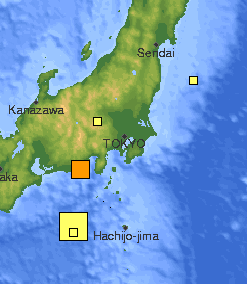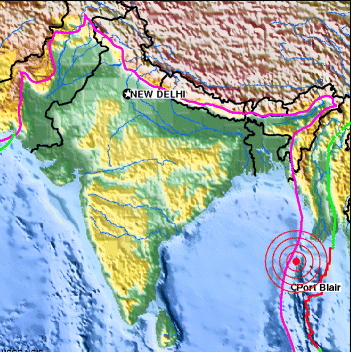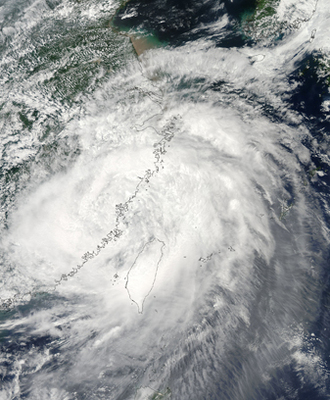
by Erin Wayman Thursday, January 5, 2012

A magnitude-7.1 quake (large yellow box) hit Japan on Aug. 9. A magnitude-6.4 quake (orange box) hit on Aug. 10. U.S. Geological Survey

A magnitude-7.6 earthquake hit the Andaman Islands on Aug. 10. U.S. Geological Survey

Satellite image of Typhoon Morakot on Aug. 9. Jeff Schmaltz, MODIS Land Rapid Response Team, NASA GSFC
August is shaping up to be a hazardous month for Asia — from the Andaman Islands in the Indian Ocean to Japan. In just the first half of the month, several earthquakes and two typhoons have struck the region. Here’s an update on these damaging events.
At 7:55 p.m. local time on Aug. 9, a magnitude-7.1 earthquake struck near Japan’s Izu Islands, 325 kilometers southwest of Tokyo. No death or damages have been reported.
The quake occurred within the seismically active Izu-Bonin subduction system, where the westward-moving Pacific Plate collides with and dips below the Philippine Sea Plate. Deformation on the Pacific Plate led to the earthquake at a depth of about 300 kilometers, well below the Philippine Sea Plate, according to the U.S. Geological Survey’s Earthquake Hazards Program. The quake’s great depth prevented any damage or tsunamis from happening.
But less than two days later, at 5:07 a.m. on Aug. 11, a more destructive earthquake hit off the south coast of Japan’s main island, 175 kilometers southwest of Tokyo. The magnitude-6.4 quake killed one woman and injured several dozen people, according to the Associated Press. Two nuclear reactors automatically shut down in response to the shaking and several of Japan’s high-speed bullet trains temporarily stopped running.
Although smaller than the first earthquake, the magnitude-6.4 temblor caused more damage because it occurred at a much shallower depth of just 26 kilometers, USGS reports. The quake occurred near a tectonically complex triple junction where the Philippine Sea Plate, the Amur Plate and the Okhotsk Plate meet. In this case, the quake happened where the northwest-moving Philippine Sea Plate slides below the Amur Plate. The temblor did not occur at the interface between the two plates, USGS says, but it’s too early to tell which plate ruptured.
Damage from the quake was intensified by Typhoon Etau. The storm reached western Japan on Monday, bringing strong rain and winds with speeds up to 126 kilometers per hour, according to Agence France-Presse. Etau has caused flooding and mudslides, killing at least 13 people. More than a dozen people are still missing.
Only minutes before the magnitude-6.4 earthquake shook Japan on Aug. 11, an unrelated magnitude-7.6 quake rocked India’s Andaman Islands in the Bay of Bengal. There were no deaths or major damage, and a tsunami warning for the Indian Ocean issued by the Pacific Tsunami Warning Center in Hawaii was later canceled.
The quake, which occurred on the same fault as the magnitude-9.0-plus Sumatra-Andaman earthquake that rattled the islands in December 2004 and triggered a massive tsunami, was likely an aftershock of that quake, despite happening four and a half years later, says Paul Caruso, a geophysicist at USGS’ National Earthquake Information Center in Golden, Colo.
Although the two earthquakes may be related, the aftershock had a different style of faulting than the main event. The 2004 quake was the result of thrust faulting (in which one block of rocks is pushed up relative to the fault) at the interface between the subducting India Plate and the overriding Burma Plate. The quake on Aug. 11 happened near the north end of the 2004 quake's rupture zone at a depth of 33 kilometers, USGS reports, but was due to normal faulting (in which one block of rocks slips down relative to the fault) on the India Plate.
In the past five days, Typhoon Morakot has battered the Philippines, Taiwan and China with powerful winds and a deluge of rain, leaving floods and mudslides in its wake. So far, the storm has killed 21 people in the Philippines, at least 50 in Taiwan and eight in China, AP reports.
On Aug. 7, the typhoon struck Taiwan with winds up to 119 kilometers per hour and poured as much as two meters of rain on the island. The rain led to massive mudslides, including a mudslide on Aug. 9 that buried the village of Shiao Lin. Initially, at least 400 villagers were missing after the mudslide, but Taiwan’s military has since found about 300 people, according to AP. Rescue operations are still ongoing.
By the time Morakot reached China on Aug. 10, the typhoon had been downgraded to a tropical storm. Still, officials evacuated nearly a million people from the coastal provinces of Fujian and Zhejiang, according to the New York Times, and the storm flattened hundreds of buildings.
© 2008-2021. All rights reserved. Any copying, redistribution or retransmission of any of the contents of this service without the expressed written permission of the American Geosciences Institute is expressly prohibited. Click here for all copyright requests.